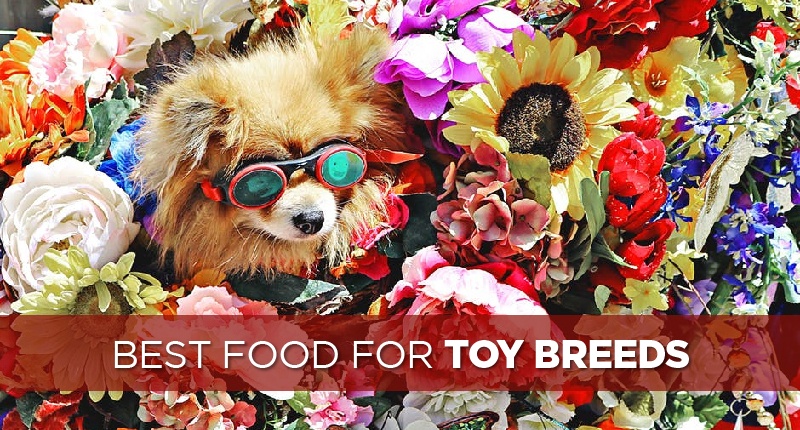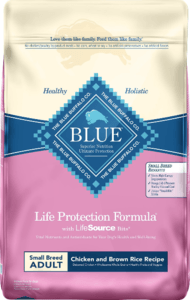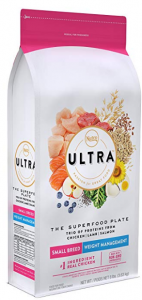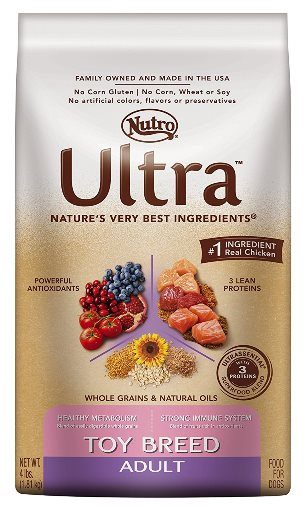Toy Breed Dog Food Recommendations: Best 5 (For All Budgets)

There’s nothing like a tiny, cute little dog curling up on your lap (or, if you have a dog like ours, your shoulder). So it makes sense that you’d want to keep your little furball as healthy as possible for as long as possible, which means you probably want to find a great food. And that’s important because the best food for toy breeds isn’t necessarily the same as the best dog foods overall.
These little guys and gals have some special nutritional requirements, and it pays to know which ingredients—and which types of food—will help them stay healthiest. And that’s why we consulted with a few of our favorite dog experts and tested a bunch of different dog foods to figure out what exactly toy breeds need from a great dog food. So we’ll go over that stuff, and at the end, we’ll give you five good recommendations for specific foods. Sound cool? Good! Let’s get started, in this review we'll find the best dog food for small breeds!
Quick Toy Breed Dog Food Recommendations
**Below, you'll find our expert's science-backed reviews, but you can also click the links above to see current prices or read customer reviews on Chewy.
Calorie Example for a 10-Pound Dog
**Please note: these estimates are based on an average weight for this breed. Every dog is different. Please talk to your vet before making changes to your dog's diet.


A Few Dog Food Recommendations for Toy Breeds
There’s no shortage of fantastic dog foods out there. So this isn’t an exhaustive list. We just didn’t want you to leave without something you could actually go try. So here are some of our favorites.
Best Small Breed Dog Food - Wellness Complete Health Dry Dog Small Breed Adult
This isn’t the first time we’ve recommend a Wellness product, and it certainly won’t be the last. They just do a great job producing high-quality food with robust nutritional profiles.
The main ingredients in this formula are deboned turkey, chicken meal and salmon meal (yay fat!).
The carbohydrates come mostly from high quality grains, such as brown rice and barley, which you may want to avoid if your pup has allergies.
What we really like, though (and what Wellness tends to do well almost all of the time) is the crazy variety of fruits and veggies. In this recipe, there’s tomatoes, carrots, spinach, applies, blueberries, and a bunch of other good stuff.
Our pup has tasted a few products from this brand, and she’s totally loved them all.
Runner Up for the Best Dog Food for Toy Breeds - Blue Buffalo Small Breed Chicken & Rice Dog Food
This is another good dog food that checks pretty much all of our boxes for toy breeds.
Most of the protein comes from deboned chicken and chicken meal, which are great sources of protein, and make this a meat-rich formula. It also contains menhaden fish meal, which is an excellent source of fatty acids.
It’s not a grain-free dog food, so the carbohydrates mostly come from barley and brown rice.
However, there’s lots of great produce here: whole carrots, whole sweet potatoes, barley grass, parsley, blueberries and a few more.
Overall, it’s a good, solid, wholesome food, and we’ve fed our dog plenty of it.
Best Senior Dog Food for Small Breeds - Nutro Ultra Adult Toy Breed Dry Dog Food
This is another great, well-rounded dog food for a smaller dog.
It’s protein-rich, and the main ingredients are chicken and chicken meal. You’ll also find a few other good protein sources, like lamb meal and salmon meal.
We also really like all the awesome vegetables and fruits in here.
This recipe includes stuff like blueberry, cranberry, pumpkin, spinach and carrots.
As for carbohydrates, most of that comes from rice and rice bran, so if you’re looking for a grain-free recipe, this may not be the best bet. Still, it’s a solid buy—especially for the money.
Grain Free Dog Food for Small Breeds - Castor & Pollux Organix Small Breed Grain-Free Adult Dog Food
Castor & Pollux generally makes pretty high-quality dog food, and this one is a particular standout for the brand.
Obviously, the cool thing about this particular recipe is that virtually everything is organic. It includes organic chicken, organic tapioca, organic peas, organic potatoes, organic chicken meal and a few other great, organic ingredients.
It also contains a few great sources of omega fatty acids (salmon meal and flaxseed) as well as chicken liver, which is a good source of calcium.
The major, glaring drawback, though is the lack of produce. There’s almost no fruits and veggies in here. That doesn’t mean you shouldn’t try it; it just means you shouldn’t keep your dog on it forever and/or you should supplement those things on your own.
Important Macronutrients & Antioxidants for Toy Breeds
Protein
For big dogs, you really have to pay a lot of attention to protein, since it’s important to preserve all that muscle mass, especially for bigger active dogs.
This is less important for toy breeds, since they’re not going to be pulling any plows. However, having plenty of protein in a diet is important for any dog.
We generally recommend that you look for dog foods that have protein content of 25% or more. You need more for a big, muscular dog, but for a toy breed, 25% is totally fine.
The most important thing is to make sure the first ingredient in your dog’s food is a source of protein.
Carbohydrates
The most important things to remember about carbohydrates are: (1) some sources of carbohydrates cause annoying health problems, (2) some carb-rich ingredients are crab and (3) a carb-rich diet makes it easier for your dog to gain weight.
Specifically, some sources of carbs tend to cause allergic reactions in some dogs—mostly wheat, corn and white potatoes. You’ll still find some of these in some dog foods, and some of them (wheat and potatoes) are totally fine if your dog isn’t allergic to them or have an related problem.
However, avoid corn. It’s just not a good ingredient, really. And you’ll have to be careful, it’s very prevalent in some major dog food brands.
Fats
Most dog foods will have plenty of fat. The thing you really want to look out for here is that there are some good sources of omega fatty acids.
Mostly, you’ll want to see either fish or flaxseed in your dog food.
Also, lots of toy breeds (e.g. maltese) have long hair, and dogs with long hair tend to do better with more fat, since it helps keep that coat shiny.
Antioxidants
One of the cool things about toy breeds is that they tend to live a really long time. Some breeds can live as long as 18 years!
With a lifespan that long, you really want to make sure your pup is getting enough antioxidants. Antioxidants can help prevent damage from free radicals, which contributes to aging. And really, the stuff that provides antioxidants is great stuff to have in a diet, anyway.
There are plenty of foods that contain lots of antioxidants. Here are the ones most commonly found in dog foods: blueberries, most varieties of red berries, leafy green vegetables, sweet potatoes, beans and fish.
*Note: Grapes show up on a lot of “antioxidant food” lists. Grapes are toxic to dogs and should be avoided.
As a general rule, we prefer to feed our dog food that contains lots of whole produce, and we give preference to foods that contain the ingredients listed above. Usually, we’re checking for good sources of protein, but a nice variety of produce is the next thing we look for.
Toy Breed Diet & Nutritional Requirements
Calories
First things first: toy breeds need fewer calories.
And that can be both a blessing and a curse. On the one hand, having a dog that doesn’t need many calories means you’re probably going to save quite a bit of money.
Feeding our dog is an absolute breeze, and she isn’t even a toy breed (she’s about 15 pounds, which is actually within some people’s definition of “toy breed,” but we tend to think of them as smaller dogs). A 12-lb bag of dog food lasts about a month for us. So yea. It’s nice and cheap.
On the other hand, it also makes it much, much easier to overfeed them. Even overfeeding by a little can amount to quite a bit of extra food (relatively speaking), since each extra scoop ends up being lots of calories for each pound of body weight.
Additionally, smaller dogs tend to have much higher metabolic rates (especially dogs like chihuahuas and Yorkies), so they might need more calories per pound of bodyweight than a larger dog.
For example, a dog that weighs in at 10 pounds might need about 400 calories daily, while a big ol’ hundred-pounder might need 2,200.
Don’t worry, I’ve done the math for you: that works out to about 40 calories per pound of bodyweight for the little dog and about 22 for the bigger pup.
If you’re not sure how many calories your dog needs, you should (of course) talk to your vet. In the meantime, we really love the dog calorie calculator at DogFoodAdvisor.
Wet vs Dry Food
For toy breeds, we typically recommend dry dog food.
Don’t get me wrong here: there are tons and tons of absolutely fantastic wet dog foods. We can't recommend the best wet dog food for small breeds and generally recommend dry kibble for one reason: toy breeds are prone to dental problems.
These tiny fluff balls tend to have problems with their teeth, and dry kibble does a good job cleaning them—just because of their natural texture.
For our pup, we also supplement her dry kibble with the occasional tasty dental chew.
Toy Breed Health Problems & How Solve Them with Food
Obesity
Let’s face it: owners of toy dogs tend to be pampers. I know I am. And people who pamper tend to be people who overfeed their dogs.
As we mentioned before, overfeeding a toy dog is very, very easy, and obesity can cause all kinds of problems down the road.
To avoid inadvertently helping your pup get pudgy, shoot for a high-protein, low-carb diet and lay off the table scraps!
Joint Problems
Bone and joint problems aren’t as much of a problem as they are for the larger, more active breeds.
However, toy breeds tend to live so long that we recommend dog foods that promote bone and joint health, since that’s often the first thing to go in a dog’s old age.
To keep your companion’s joints healthy, look for foods that contain glucosamine, calcium and chondroitin, which help bones, joints, and cartilage stay lubricated and healthy.
Eye problems
For whatever reason (I honestly don’t know), toy breeds are prone to eye problems, and they disproportionately lose their eyesight, especially in old age.
To help prevent this and keep your pup’s peepers in tip-top shape, include foods that have lots of beta-carotene.
Some dog foods will add this as a supplement, but the best dog foods for toy breeds include it in the form of whole vegetables. Usually, orange-colored veggies have the most beta-carotene, which is why so many of the foods we recommend (below) include carrots and pumpkin.
If you enjoyed this article, you'll probably thing this one on Weimaraners is out of this world. And here's a good guide to feeding a Chihuahua. We also have some information on low fat dog food. We also published a post on dental chews for your pup.
**Disclaimer: Our dog food reviews are based mostly on (1) our expertise and that of the experts with whom we consult and (2) the information provided by the manufacturers. We do test many dog foods (with our dog's help), but we can't test them all. As such, please remember the above recommendations are our opinions, and you should consult your vet before making changes to your dog's diet.







